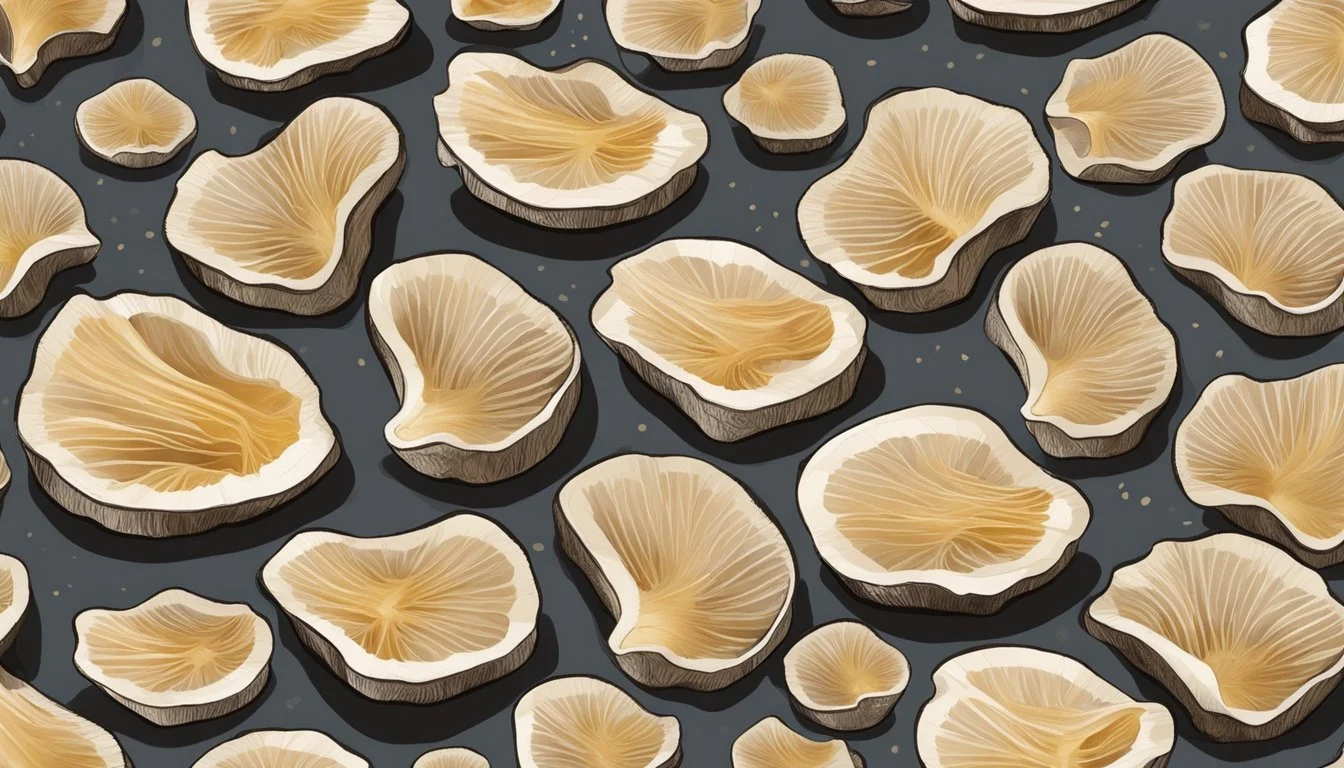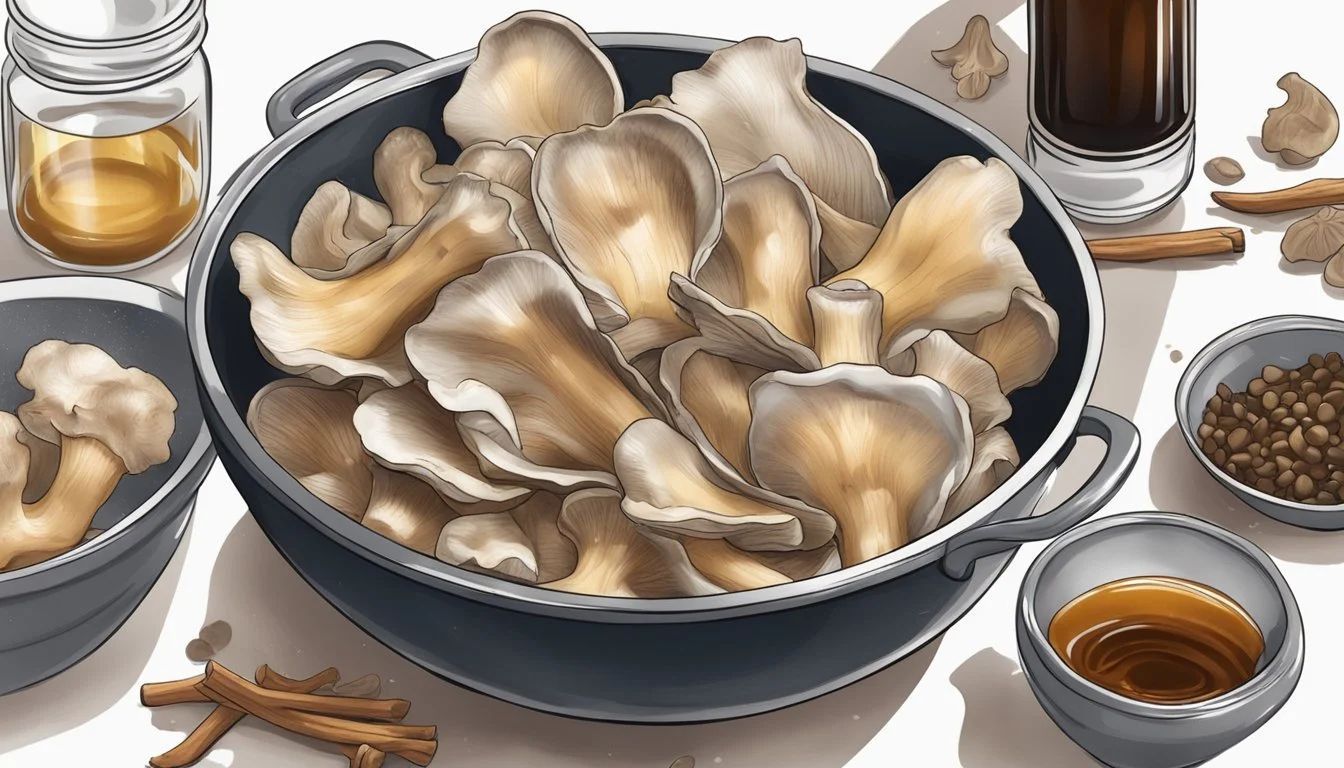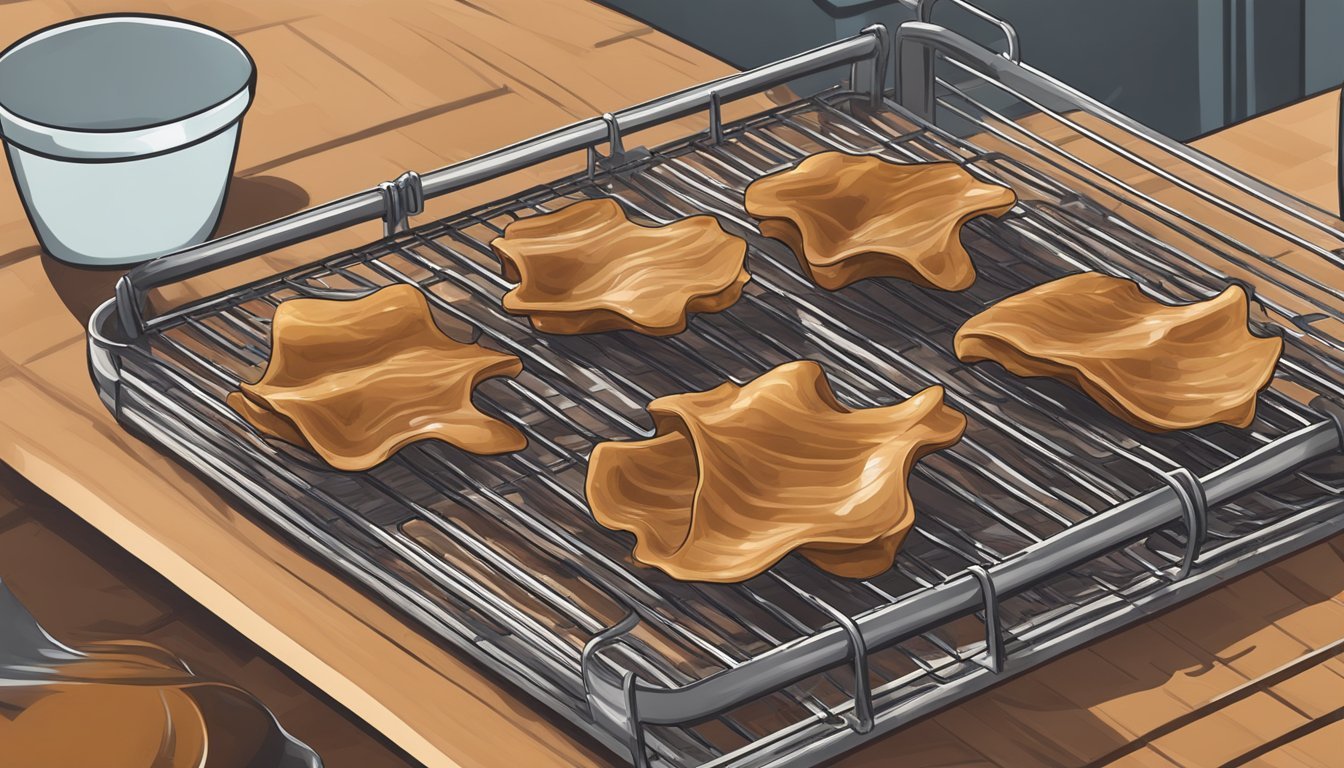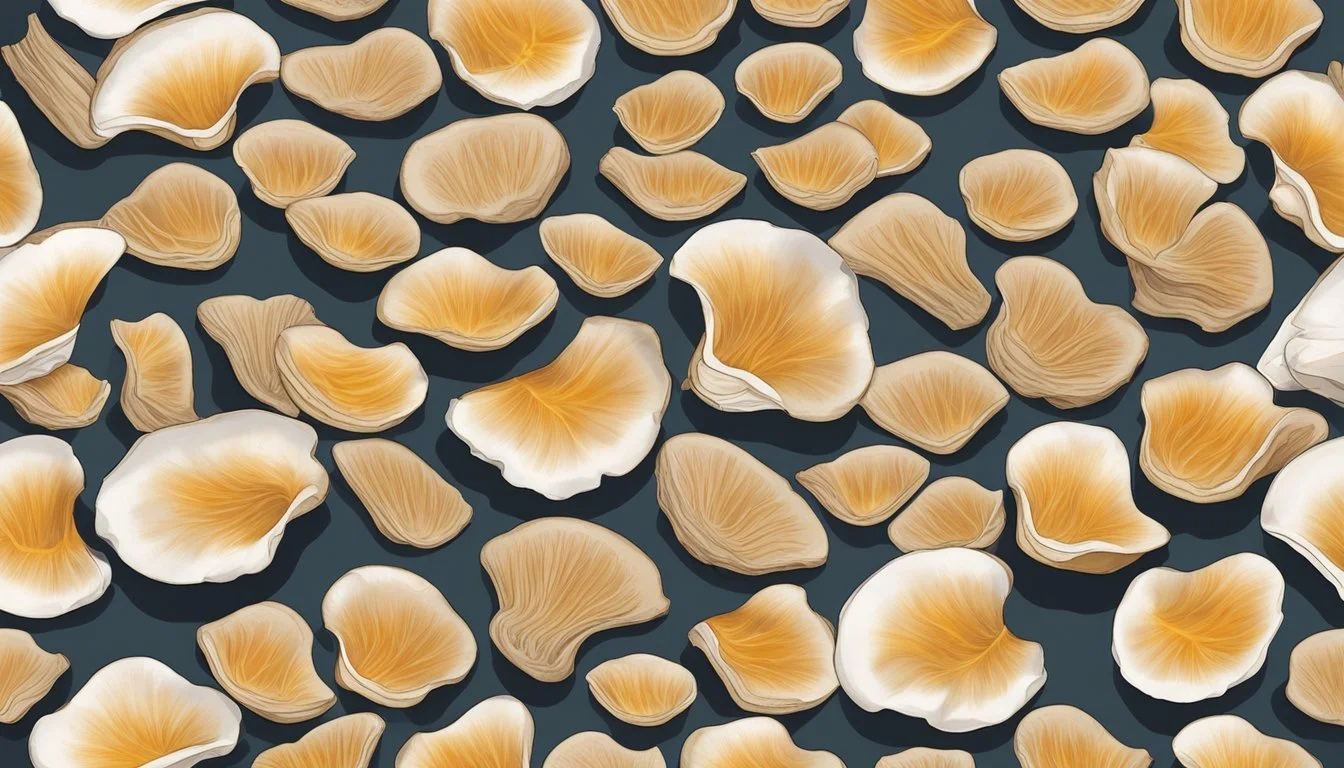How to Make Flavorful Oyster Mushroom Jerky from Scratch
Your Ultimate Guide
Oyster mushroom jerky is a savory snack that offers a delightful blend of earthy flavors (What wine goes well with earthy flavors?) and a meaty texture, making it a popular choice for both vegetarians and meat-eaters alike. Crafting this jerky from scratch allows for a personalized touch to the seasoning, resulting in a snack that is both healthy and customizable. Oyster mushrooms are particularly well-suited for jerky due to their robust structure and ability to absorb an array of marinade flavors.
The process of making oyster mushroom jerky begins with the careful preparation of the mushrooms (What wine goes well with mushrooms?), ensuring that any dirt or debris is removed. Once cleaned, the mushrooms are sliced into uniform strips to promote even dehydration. A flavorful marinade is essential, as it infuses the mushrooms with a depth of flavor. Common ingredients include soy sauce, garlic, ginger, and various spices, which together create a rich and umami-driven taste profile.
The marinated mushroom slices are then dehydrated, a crucial step that intensifies the flavors and achieves the desired chewy texture. Dehydration can be done with a food dehydrator or in a low-temperature oven. The result is a batch of homemade oyster mushroom jerky that is not only satisfying to eat but also a testament to the simplicity and elegance of plant-based snacking.
Understanding Oyster Mushrooms
Before delving into making oyster mushroom jerky, it's essential to understand the unique characteristics of oyster mushrooms and how to select the best specimens for this flavorful snack.
Characteristics and Nutritional Value
Oyster mushrooms, known for their distinct shell-like appearance and savory umami flavor, are a popular choice for culinary uses due to their texture and taste. Nutritionally, they are low in calories yet high in beneficial components such as vitamins and minerals. They are particularly rich in niacin (Vitamin B3), which plays a vital role in energy metabolism and maintaining healthy skin.
Texture: Velvety and tender
Flavor: Distinct umami with a subtle earthiness
Nutrition:
Calories: Low
Vitamin B3 (Niacin): High
Potassium and antioxidants: Present
Selecting the Best Mushrooms for Jerky
Selecting the highest quality oyster mushrooms is crucial for creating delicious jerky. The best mushrooms can typically be found fresh in the produce section of a grocery store, at a farmer’s market, or in specialty stores such as Whole Foods. When choosing mushrooms, they should have:
Appearance: No visible damage and a fresh, healthy color.
Firmness: They should feel firm to the touch, indicating freshness.
Size: Medium-sized caps are ideal, as they are easier to work with for jerky slices.
For those with access to natural regions where oyster mushrooms grow, one can also forage for them; however, knowledge and caution are advised to ensure correct identification and safe consumption.
Preparing the Mushrooms
Proper preparation of oyster mushrooms is crucial for achieving the desired texture and ensuring even drying. This section walks through the meticulous process of cleaning and slicing the mushrooms, as well as the importance of cutting techniques for texture optimization.
Cleaning and Slicing
Cleaning: Before slicing, one must clean the oyster mushrooms thoroughly to remove any debris and dirt. Steps for cleaning include:
Gently brushing off loose particles using a soft brush.
Using a knife to scrape away any stubborn bits.
Cutting off the woody end of the stem where the mushrooms were attached to the substrate.
Slicing: Once clean, the next step involves slicing the mushrooms. For uniform drying and consistent results, one should cut the mushrooms into strips that are approximately 2-3 inches in length and about an inch wide.
Here is a simple guide for slicing:
Length: 2-3 inches
Width: ~1 inch
Thickness: Consistent for even drying
Choosing Cutting Techniques for Texture
The cutting technique significantly affects the texture of the final jerky product. For chewier jerky, one might opt for thicker slices, while thinner strips will result in a crisper outcome. Regardless of the chosen thickness, it is essential to maintain uniformity.
Techniques to consider:
Thick slices: For a chewy, meaty texture, slice the mushrooms slightly thicker. This mimics the bite of traditional jerky.
Thin strips: For a crispier texture, one should slice mushrooms into thinner pieces that will dry more quickly and become crisp.
In summary, the chef must ensure that the mushrooms are clean and that their size is conducive to the desired jerky texture. With meticulous slicing, the oyster mushrooms will dehydrate evenly, producing a flavorful and texturally pleasing jerky.
Creating the Marinade
Crafting a flavorful marinade is crucial for making oyster mushroom jerky. It infuses the mushrooms with rich flavors, transforming them into a savory snack.
Designing Flavor Profiles
A well-designed flavor profile can elevate oyster mushroom jerky from simple to extraordinary. For a bold and savory taste, soy sauce or tamari serves as the base, both offering depth with their umami richness. For those seeking a vegan or gluten-free alternative, tamari, coconut aminos, or liquid aminos can replace soy sauce. Maple syrup or agave nectar adds a touch of sweetness, balancing the saltiness of the soy base, and is especially appealing for a vegan jerky.
A smoky aroma is often desired and can be introduced with smoked paprika or a few drops of liquid smoke. To create complexity, acids such as apple cider vinegar or rice vinegar cut through the umami and sweetness, adding a bright note that teases the palate.
The spice level can be adjusted with black pepper, garlic powder, onion powder, and red pepper flakes for those who enjoy a spicy kick. This invites a versatile canvas where heat can be tailored to individual preference.
Combining Ingredients for Umami
The pursuit of the ultimate umami in a mushroom jerky marinade requires careful selection and combination of ingredients.
Ingredient Quantity Purpose Soy sauce/Tamari 1/2 cup Umami foundation, saltiness Maple syrup 1/4 cup Sweetness Apple cider vinegar/Rice vinegar 2 tbsp Acidity, flavor contrast Smoked paprika 1 tsp Smoky aroma Garlic powder 1 tsp Savory kick Onion powder 1 tsp Richness Red pepper flakes 1/2 tsp Heat Liquid smoke 1/2 tsp Intense smokiness Sesame oil/Olive oil 1 tbsp For richness and mouthfeel
Mix these ingredients together until they are thoroughly combined. When incorporating olive oil or sesame oil, they not only add a layer of richness but also assist in the distribution of flavors throughout the marinade. For every added spice or condiment, one ensures that each slice of mushroom is thoroughly coated, soaking up the complex array of flavors crafted for the ultimate snacking experience.
Marinating the Mushrooms
Marinating oyster mushrooms is crucial for infusing them with flavors that turn into a satisfying, meaty snack. The marinate comprises a balance of ingredients to coat the mushrooms effectively.
Techniques to Maximize Flavor Absorption
To ensure the oyster mushrooms fully absorb the marinade, they should be cleaned and sliced into uniform strips before being placed in the marinating liquid. Here is a step-by-step process to maximize flavor absorption:
Slice Cleanly: Cut mushrooms into even, 2-3 inch long strips, about an inch thick, to allow even exposure to the marinade.
Marinade Mixture: Combine all marinade ingredients thoroughly—common ingredients for a robust marinade include soy sauce, minced garlic, ground ginger, and sometimes sweeteners like maple syrup or a smoky element like liquid smoke.
Ensure Coverage: Submerge mushroom strips entirely in the marinade. Use a large ziplock bag or a bowl with a tight-fitting lid to facilitate an even coat.
Toss Regularly: By stirring the mushrooms several times during the marination process, each piece is re-exposed to the marinade, enhancing flavor uptake.
Ideal Marinating Times
The duration for which the mushrooms should be left to marinate is key for optimal flavor infusion.
Minimum Time: A minimum of 30 minutes is mandatory for mushrooms to start absorbing the flavors.
Overnight Soak: For a deeper, more pronounced flavor, it's best to allow the mushrooms to marinate overnight in the refrigerator, turning them occasionally to ensure all pieces are equally seasoned.
Temperature Matters: Keep the marinating mushrooms in a cool environment, ideally in the refrigerator, to maintain food safety while they soak up the seasoning.
By adhering to these techniques and times, one can create a batch of oyster mushroom jerky that is rich in flavor and has a satisfying texture.
Drying the Mushroom Jerky
Once oyster mushrooms are marinated, the drying process is crucial to transform them into a chewy, flavorful snack. Both consistency of texture and preservation depend on this step.
Using a Dehydrator for Consistent Results
A food dehydrator is an excellent tool for making jerky due to its ability to maintain a consistent low temperature, which is essential for even drying. To dehydrate mushroom jerky, one should lay the marinated slices in a single layer on the dehydrator trays. It is important to leave space between the slices for air circulation.
Dehydrator Temperature: Set at 100 F (38 C)
Cooking Time: Approximately 5-6 hours
Maintenance: Rotate trays 180 degrees halfway through drying
This method assures a consistent texture and prevents the jerky from becoming too tough or leathery.
Oven Drying vs. Air Fryer Methods
When a dehydrator is not available, the oven or an air fryer can be alternatives, albeit each with its nuances.
Oven Drying:
Temperature: Set to the lowest possible, ideally around 150 F (65 C)
Door Ajar: Keep the oven door slightly open to allow moisture to escape
Cooking Time: Can vary widely, generally between 4-6 hours
One should monitor the jerky closely in the oven, as the higher temperatures can cause uneven drying.
Temperature: Similar to the oven, set to the lowest setting
Timing: Shorter than an oven or dehydrator, usually around 1-2 hours
Circulation: Some air fryers provide excellent air circulation which can expedite the drying process
However, using an air fryer can result in a different texture due to the faster dehydration process. Adjustments may be necessary to prevent the jerky from becoming too crisp or burnt.
Storing and Preserving Jerky
Proper storage extends the shelf life of oyster mushroom jerky and retains its flavor. Containers play a crucial role in keeping jerky fresh, while understanding refrigeration tips helps maintain quality over time.
Selecting Proper Containers for Freshness
When storing oyster mushroom jerky, one should opt for airtight containers to prevent moisture and contaminants from affecting the jerky's quality. These containers come in various materials like glass or food-grade plastic. Vacuum sealing is another excellent option, especially for long-term storage, as it removes air that could facilitate spoilage.
Glass jars with tight-fitting lids
Food-grade plastic containers with airtight seals
Vacuum-sealed bags for maximum freshness
Shelf-Life and Refrigeration Tips
At room temperature, oyster mushroom jerky can last for a couple of weeks when stored in a cool, dry place away from direct sunlight. However, refrigeration significantly extends its shelf life.
Room Temperature: Up to 2 weeks in an airtight container
Refrigerator: Up to 1 month for maintained freshness
To preserve the jerky's texture and taste, one should ensure:
The jerky is completely cool before storage to prevent condensation.
The container is placed in the coolest part of the refrigerator, away from the door.
It's recommended to check the jerky periodically for any signs of spoilage and consume within the advised time frames for best quality.
Serving and Enjoying
Homemade oyster mushroom jerky is not only a delicious snack, but it also offers versatility in how it can be enjoyed due to its savory flavor and substantial texture. This section guides you through inventive serving suggestions and complementary pairings that can elevate your snacking experience.
Creative Ways to Serve Mushroom Jerky
One can serve mushroom jerky as part of a charcuterie board, offering a plant-based alternative to traditional meats. Its chewy texture and rich umami flavor make it an instant hit. For an extra burst of flavor, one might consider offering a small dish of dipping sauce, such as spicy sriracha or a tangy barbeque sauce, to enhance the jerky's taste.
Additionally, mushroom jerky can be chopped and added to salads for a protein-packed crunch or used as a topping on soups and stews, providing an enjoyable contrast to softer textures in the dish.
Pairing with Other Foods
Mushroom jerky pairs well with various foods that complement its savory profile. The table below lists food pairings that can either bring out the best in your mushroom jerky or provide a delightful contrast:
Pairing Category Foods to Consider Beverages Craft beers, bold red wines, iced green tea Cheeses Aged cheddar, gouda, vegan nut cheeses Fruits Dried apricots, apple slices, grape halves Nuts Almonds, cashews, walnuts
These pairings are not only enjoyable taste-wise but also help balance calories, resulting in a satisfying snack or appetizer with a mindful approach to serving sizes. The goal is to create a recipe for a delightful eating experience where every bite is savored.
Alternative Mushroom Varieties for Jerky
While oyster mushrooms are a popular choice for making jerky due to their meaty texture, other varieties also offer robust flavors and textures well suited for jerky preparation. Many of these alternatives are readily available in the produce section of grocery stores or can be foraged from the wild.
Portobello and Shiitake Jerky
Portobello mushrooms, known for their large, hearty caps, make an excellent substitute for oyster mushrooms when crafting jerky. To prepare portobello jerky, the caps should be sliced into ¼-inch thick pieces to ensure even dehydration. The rich, earthy flavor of portobellos lends itself well to smoky or savory marinades.
Shittake mushrooms, on the other hand, are smaller but packed with a smoky, rich flavor, ideal for a jerky that seeks to impress with its depth of taste. For shiitake jerky, stems should be removed as they're tough and inedible, with the caps sliced to maintain uniformity in thickness for consistent drying.
Foraging for Wild Mushrooms like Hen of the Woods
For those inclined towards foraging, Hen of the Woods (also known as Maitake) presents itself as a distinguished option. This wild mushroom is revered for its complex flavor and firm texture, which can produce a jerky that stands out in both taste and structure. It is crucial for foragers to ensure correct identification and to harvest sustainably to maintain local ecosystems. Hen of the Woods slices should be cleaned and marinated like their cultivated counterparts to create a unique plant-based jerky variant.
When experimenting with these alternative mushrooms, enthusiasts will find that the plant-based jerky world is rich with variety, each offering a unique twist on the traditional vegetarian snack.
Advanced Tips and Tricks
Crafting the perfect batch of flavorful oyster mushroom jerky requires attention to seasoning and texture control. This section details how to enhance both aspects for a superior homemade snack.
Experimenting with Different Flavors
When making oyster mushroom jerky, the flavor profile can be as varied as one's imagination. To discover a unique taste, they can consider the following substitutions and additions:
Sweet: Add a touch of maple syrup or brown sugar.
Spicy: Incorporate chili flakes or hot sauce for heat.
Savory: Combine soy sauce, Worcestershire, or liquid smoke.
Herbal: Herbs like thyme, rosemary, or smoked paprika lend complexity.
A quick reference for flavor experimentation:
Flavor Type Ingredient Options Sweet Maple syrup, brown sugar Spicy Chili flakes, hot sauce Savory Soy sauce, Worcestershire sauce, liquid smoke Herbal Thyme, rosemary, smoked paprika
They should not be afraid to mix and match the above to find the right balance that appeals to their palate.
Mastering Texture and Chewiness
Achieving the ideal chewy texture requires precision in both preparation and cooking:
Thickness: One should slice mushrooms into uniform strips, about 1 inch thick, to ensure even dehydration and sufficient chewiness.
Dehydration: It's crucial to dehydrate at a low temperature—typically around 100°F to 180°F (38°C to 82°C)—for several hours. Checking the jerky occasionally will prevent it from becoming too crispy.
For those seeking a crispy alternative to chewy jerky, they should slice the mushrooms thinner and increase the dehydration time. Conversely, a shorter dehydration period at a slightly higher temperature can yield a jerky that is more on the tender side. Regularly flipping the mushroom slices and rotating the trays ensure an even texture. Flipping intervals can vary, though a good start is at 30-minute increments.
Remember, the objective in tweaking these variables is to customize the jerky to one's preference, be it chewy or with a slight crisp.
Health and Dietary Considerations
Choosing to make oyster mushroom jerky offers healthful benefits and fits into various dietary needs. Plant-based and vegan diets can particularly gain from incorporating such snacks, considering their nutrient profile and low-carb nature.
Benefits of a Plant-Based Snack
Oyster mushroom jerky is a plant-based snack that provides essential nutrients without the need for animal products. The vegan community appreciates this jerky because it aligns with a cruelty-free lifestyle while delivering a savory, meaty texture. It's high in fiber and contains various B vitamins, potassium, and beta-glucans known for immune support. As a low carb option, it satisfies snack cravings without the glycemic impact of traditional snacks.
Calories and Macronutrients in Oyster Mushroom Jerky
Calories and macronutrient distribution in oyster mushroom jerky can vary depending on the recipe and serving size, but it typically remains a low-calorie option. A general nutritional breakdown for a single serving might look like this:
Calories: Approx. 50-70 kcal
Carbohydrates: 10-15g
Protein: 2-5g
Fat: Minimal, unless added through seasoning or cooking method
By being naturally low in calories and carbs, oyster mushroom jerky fits well into low-carb and calorie-controlled diets. Its nutritional profile makes it a suitable snack for those looking to maintain or lose weight without sacrificing taste or texture.
Frequently Asked Questions
This section addresses common questions and provides expert insights into the process of making flavorful oyster mushroom jerky.
Catering to Common Concerns and Curiosities
Readers often inquire about whether oyster mushroom jerky is suitable for a vegan or plant-based diet. The answer is affirmative; oyster mushroom jerky is a vegan snack as it is made from mushrooms, which are a fungus, and typically seasoned with plant-based ingredients. Here is a quick guide on essential points:
Vegan Friendly: Oyster mushroom jerky is a natural fit for vegans, using only mushrooms and a variety of spices and seasonings that contain no animal products.
Plant-Based Protein: Mushrooms provide a source of protein, making this jerky a nutritious option for those following a plant-based diet.
Expert Answers to Reader Inquiries
Experts can provide guidance on more specific queries, such as substitutions in the recipe or tips for foraging mushrooms like Berkeley's polypore. Below is a structured rundown:
Substitutions: Readers may substitute soy sauce with tamari for a gluten-free option or utilize different spices to tailor the flavor to personal preference.
Foraging: For those interested in foraging, it is recommended to gather oyster mushrooms or Berkeley’s polypore from the wild only with adequate knowledge, or under the guidance of an experienced forager, as misidentification can be dangerous.
When following a mushroom jerky recipe, attention to detail in the preparation and cooking process is crucial for achieving the best texture and flavor.
Connecting with the Community
In the world of oyster mushroom jerky making, enthusiasts and experts alike find immense value in communal knowledge-sharing. Facebook provides a platform for exchanging innovative recipes and techniques, while regional foraging groups in Asia can broaden a forager's expertise with local mushroom varieties and foraging hotspots.
Sharing Recipes and Tips on Facebook
Facebook groups dedicated to mushroom jerky bring individuals together to share personal recipes and preparation tips. Members can post photos of their homemade jerky, ask for advice on seasoning blends, and contribute suggestions for improving texture and flavor. For those beginning their journey in mushroom jerky making, such groups can offer:
Step-by-step preparation guides
Reviews of dehydrators or other essential equipment
Unique flavor combinations discovered by community members
Finding Mushroom Foraging Groups in Asia
Asia's lush forests are a treasure trove for mushroom foragers. Joining a local assemblage provides rich opportunities to:
Learn from seasoned foragers: They can share insights on the best seasons and locations for finding oyster mushrooms.
Participate in group forays: These events can enhance one’s ability to identify and harvest edible mushrooms safely.
Foragers can exchange information on foraging laws and sustainability practices, ensuring that the pursuit of oyster mushrooms is both legal and environmentally conscious.








